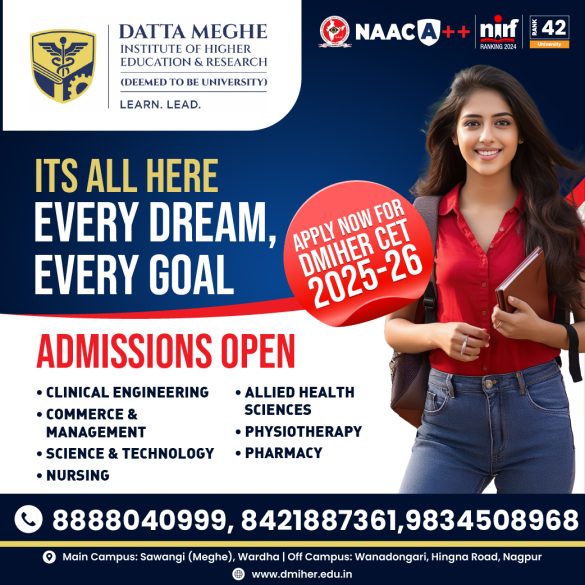As the Nagpur Municipal Corporation (NMC) celebrates its 75th anniversary on March 2, it’s an opportune moment to reflect on its evolution. Has it become a more effective governing body, or does it still face persistent challenges in managing the city’s growth and providing essential services?
Though NMC has accomplished some significant achievements over the years, it continues to grapple with several critical issues that hinder its ability to serve the people of Nagpur efficiently.
A key concern is the absence of an elected body at the helm since 2022, with the NMC currently being administered by state-appointed officials rather than elected representatives.
A Historical Perspective
The roots of Nagpur’s urban governance can be traced back to 1864 when the city’s first municipal council was formed. Initially covering just 15.5 sq. km and serving a population of 82,000, the council’s duties were focused on basic services like sanitation, street lighting, and water supply, with the support of the government. The passage of the Central Provinces & Berar Municipalities Act in 1922 marked a step towards more structured governance. Finally, in 1951, the City of Nagpur Corporation Act gave rise to the Nagpur Municipal Corporation as we know it today.
Leadership Through the Years
Over its history, NMC has been led by 54 mayors and 56 deputy mayors, all working towards making Nagpur a more livable city. Barrister Sheshrao Wankhede was the first mayor, while Chhotelal Thakkar served as the first deputy mayor, and Sadabhau Dandige was the first chairman of the Standing Committee. The first municipal elections were held in 1951, and 42 members were elected from various city wards. As Nagpur’s boundaries expanded, the municipal jurisdiction grew to cover 217.56 sq. km, incorporating 34 villages.
Governance and Responsibilities
The NMC’s scope of responsibilities, as outlined by the CNC Act, covers a wide range of urban services. These include water supply, waste management, slum rehabilitation, road infrastructure, street lighting, parks, healthcare, and education. NMC works alongside various other agencies, such as the Nagpur Improvement Trust (NIT), MHADA, and the Maharashtra State Road Transport Corporation (MSRTC), to ensure urban growth and development. The city is divided into 10 zones for more effective administration.
Financial Constraints and Revenue Sources
One of the biggest challenges facing NMC is its financial struggles. The primary sources of revenue for the corporation are property tax, professional tax, entertainment tax, and government grants, including GST allocations. In addition, NMC generates income through water charges, documentation fees, rental income from municipal properties, and municipal bonds. However, the removal of Octroi and Local Body Tax (LBT) has placed an even greater burden on property tax, which remains the largest source of revenue, though its collection remains low.
The Challenges Ahead
Nagpur, as Maharashtra’s second capital, has high aspirations for development, but it also faces growing challenges in addressing basic civic needs. While the NMC has made strides in various areas, significant gaps remain in ensuring drinking water security, managing waste sustainably, improving infrastructure, and generating new revenue sources. The city’s expanding borders have only added to the strain on municipal resources, leaving NMC more reliant on state funding than ever.
As Nagpur’s skyline evolves and the city grows, the NMC must find innovative ways to generate revenue without placing an excessive burden on taxpayers. Whether it can transition from being a dependent body to a more self-sustaining municipal entity will determine whether the NMC can mature into an efficient urban manager in the years to come.
List of Mayors:
- B. S. Surve | 31 January 1964 – 8 February 1965
- B. K. Takkamore | 9 February 1965 – 30 September 1965
- Tejsingrao L. Bhosle | 15 April 1969 – 6 February 1970
- S. M. Meshram | 7 February 1970 – 6 January 1971
- Haribhau Naik | 7 January 1971 – 30 November 1971
- Pundlik Masurkar | 4 December 1971 – 6 January 1972
- Bhaurao Mulak | 7 January 1972 – 14 February 1973
- K. R. Pandav | 15 February 1973 – 5 February 1974
- M. M. Kinkhede | 6 February 1974 – 13 February 1975
- B. M. Gaikwad | 14 February 1975 – 7 March 1976
- Ramratan Janorkar | 8 March 1976 – 13 January 1977
- Sardar Atal Bahadur Singh | 14 February 1977 – 6 February 1978
- Shriram Vaidya | 7 February 1978 – 7 February 1979
- S. M. Chahande | 8 February 1979 – 17 February 1980
- A. A. Antik | 18 February 1980 – 11 February 1981
- Sakharam Chaudhari | 15 May 1985 – 2 February 1986
- Tejram Somkuwar | 3 February 1986 – 1 February 1987
- Pandurang Hivarkar | 2 February 1987 – 30 January 1988
- M. M. Jadhav | 25 April 1989 – 6 November 1989
- Babanrao Yewale | 3 February 1990 – 30 January 1991
- Vallabhdas Daga | 31 January 1991 – 1 March 1992
- Sudhakarrao Nimbalkar | 2 March 1992 – 3 February 1993
- Kishor Dorle | 4 February 1993 – 2 February 1994
👉 Click here to read the latest Gujarat news on TheLiveAhmedabad.com



